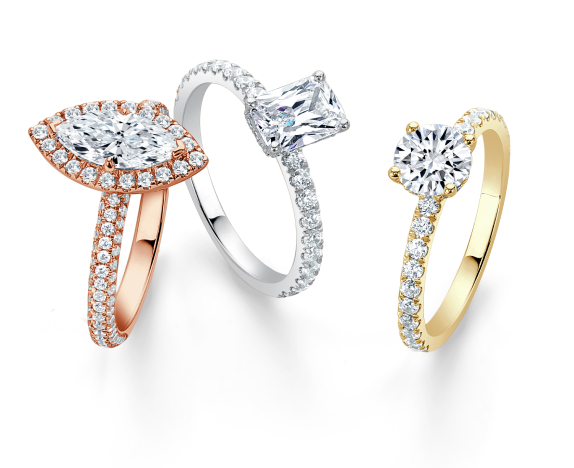Diamonds are coveted all over the world. They are one of the most sought-after stones in many different cultures and are often found in engagement rings, necklaces and other items of jewellery.
One of the largest, most valuable and most famous diamonds is the Koh-i-Noor Diamond, sifted from the sand in India and thought to be revered by the Hindu god Krishna. It was passed down through the Indian court aristocracy before eventually being looted and set in the British Crown Jewels in the mid-1800s.
Aside from diamonds like the Koh-i-Noor that have prestige from religious or cultural importance, there are a number of factors that impact any given diamond’s value, including the level of demand in the diamond industry, ethical sourcing, and the quality of the diamond itself.
Leading diamond experts at Steven Stone have put together a guide that tells you everything you need to know.

Demand & Diamond Industry
Today, the idea of engagement rings and diamonds go hand in hand, but this wasn’t always the case.
De Beers is one of the biggest names in the diamond industry, owning some of the largest diamond mines around the world and having a big influence on the industry as a whole. During the great depression in the late 1920s and early 30s, sales of diamonds were down – De Beers controlled the market completely and so their profits plummeted.
To bring back buoyancy to the diamond market, De Beers designed an advertising campaign, coining the slogan ‘a diamond is forever’. With this advertising campaign, De Beers created the discourse that solidified the relationship between diamonds and engagement rings – strengthening the market and making a lasting cultural impact.
Physical Properties
Diamonds have a range of physical properties which give them value. They are one of the hardest materials known to man, and can cut glass, marble and granite.
They are thermal conductors, resistant to pressure and act as electrical insulators.
This all means that diamonds have a lot of uses outside of jewellery manufacturing – including in medicine, high end audio equipment, and heavy-use industrial machinery and tools.
Ethical Sourcing
For many people, the ethical sourcing of diamonds is a genuine consideration. The Kimberley Process is supported by the UN and is an adopted standard throughout the diamond trade to monitor imports of rough diamonds and make sure they are conflict free.
Sourcing an ethical diamond can be more expensive, as the industry is regulated with guidelines that take money to implement. Most diamonds are extracted from miles underneath the Earth’s surface through pipe mining, or alternatively through alluvial mining – sifting through riverbeds and the ocean floor.
Deep earth mines are owned and operated by large corporations that adhere to ethical standards – the most well-known of these is De Beers.
Alluvial mining is done by hand which is a painstaking process. Although large mining companies also find diamonds through alluvial mining, some of it is also done by individuals, and this is known as informal alluvial mining. This is largely unregulated, and miners are often trafficked people or children as young as five years old who have been captured by government militias or armed rebel groups.
Unregulated alluvial mining destroys the environment and renders the land useless for mining. Wildlife is displaced and rivers are rerouted; ecosystems and communities are destroyed as a consequence.
The 4Cs
The 4Cs relate to the micro-differences between diamonds that distinguish the best diamonds from a lesser one. They have a huge impact on the price of each individual diamond.
Colour: Diamonds are colour graded from D-Z in GIA laboratories, with D being the clearest, and best. The clearer the diamond, the higher its value, however poor diamond colour can be partially concealed by other features such as clarity or fluorescence.
Clarity: Entirely flawless diamonds are so rare that most jewellers have never seen one, but the fewer imperfections a diamond has, the higher the clarity grade. A diamond’s imperfections are also known as inclusions and almost all diamonds include trace materials that will affect their clarity rating.
Carat: The carat is the most well-known feature of a diamond and refers to weight. Carat doesn’t necessarily reflect value or size, however, as it can vary depending on other aspects, such as cut and shape. Larger diamonds are rarer than smaller ones and are therefore valued more highly.
Cut: The diamond’s cut is the most significant of all features. It refers to the stone’s shape as seen from above. It affects the light dispersion. Diamond cutting requires precision and craftsmanship. The more light that the diamond reflects, the more it will sparkle.
If you’re looking for some jewellery inspiration, why not take a look at our full collection? Whether you’re after a necklace or some diamond earrings, we’ve got you covered. We also have a vast range of engagement and wedding rings.
If you don’t see anything that takes your fancy, we also offer a bespoke service, where our designers will create a unique piece of jewellery that ticks all the boxes.
Follow us on our socials
Pop over to our social platforms to keep up to date with Steven Stone’s latest jewellery content and news.







